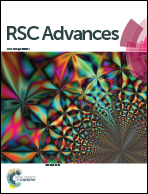Nanofiltration recovery of sericin from silk processing waste and synthesis of a lauroyl sericin-based surfactant and its characteristics
Abstract
The objective of this study was to improve silk floss processing technology. Silkworm (Bombyx mori) cocoons were quickly reeled into a raw silk sheet with cycling of hot alkaline eluent in a processing machine. The raw silk sheet was refined in the strongly alkaline electrolyzed water (SAEW) for 0.5 h, and the silk floss (degummed silk fiber equivalent to ∼40% (w/w) of the whole cocoons) was obtained as a raw material for the manufacture of silk fabrics such as silk quilts. The alkaline eluent and the refining solution were separated by an ultrafilter, the filtrate contained the sericin oligomeric peptides and free amino acids (SAA) with a low molecular mass, and the retentate was a sericin polypeptide (SP) with a range of high molecular mass values; the filtrate was again separated by the nanofiltration, obtaining the retentate contained SAA, while the filtrate became the pure water that can be recycled as the alkaline eluent; the SAA in the retentate was concentrated to about 20% (w/v) by using rotary evaporation; the finally obtained SAA was used for the synthesis of a lauroyl sericin-based surfactant (LSBS) with a yield of ∼75%. There was no clear difference between the amino acid compositions of SAA and LSBS. The surface tension and critical micelle concentration (CMC) of LSBS was much lower than that in the SAA, and LSBS had high foaming power. The emulsifying power of SAA and LSBS in an oil–water (O–W) phase with the ethyl acetate as the oil phase was better than that with the benzene. Generally, the LSBS displayed good surface properties. A novel technology in the present work was developed for the silk floss industry, facilitating efficient recovery and use of sericin as well as the recycling of water and reducing the serious environmental pollution resulting from the strongly alkaline waste that contains the sericin released from the traditional procedure.


 Please wait while we load your content...
Please wait while we load your content...